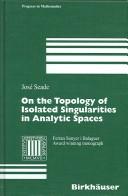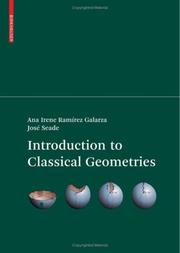| Listing 1 - 10 of 24 | << page >> |
Sort by
|

ISBN: 3764373229 9786610608867 1280608862 3764373954 9783764373221 Year: 2006 Volume: 241 Publisher: Basel Birkhauser Verlag
Abstract | Keywords | Export | Availability | Bookmark
 Loading...
Loading...Choose an application
- Reference Manager
- EndNote
- RefWorks (Direct export to RefWorks)
Functions of complex variables --- Topological Groups --- Analytic spaces --- Geometry, Algebraic --- Singularities (Mathematics) --- Topology --- 512.76 --- 512.76 Birational geometry. Mappings etc. --- Birational geometry. Mappings etc. --- Analysis situs --- Position analysis --- Rubber-sheet geometry --- Geometry --- Polyhedra --- Set theory --- Algebras, Linear --- Algebraic geometry --- Spaces, Analytic --- Analytic functions --- Functions of several complex variables
Multi
ISBN: 9783764373955 Year: 2006 Publisher: Basel Birkhäuser Verlag
Abstract | Keywords | Export | Availability | Bookmark
 Loading...
Loading...Choose an application
- Reference Manager
- EndNote
- RefWorks (Direct export to RefWorks)
Topological groups. Lie groups --- Functional analysis --- topologie (wiskunde) --- functies (wiskunde)
Book
ISBN: 9783764373955 Year: 2006 Publisher: Basel Birkhäuser Basel
Abstract | Keywords | Export | Availability | Bookmark
 Loading...
Loading...Choose an application
- Reference Manager
- EndNote
- RefWorks (Direct export to RefWorks)
The aim of this book is to give an overview of selected topics on the topology of real and complex isolated singularities, with emphasis on its relations to other branches of geometry and topology. The first chapters are mostly devoted to complex singularities and a myriad of results spread in a vast literature, which are presented here in a unified way, accessible to non-specialists. Among the topics are the fibration theorems of Milnor; the relation with 3-dimensional Lie groups; exotic spheres; spin structures and 3-manifold invariants; the geometry of quadrics and Arnold's theorem which states that the complex projective plane modulo conjugation is the 4-sphere. The second part of the book studies pioneer work about real analytic singularities which arise from the topological and geometric study of holomorphic vector fields and foliations. In the low dimensional case these turn out to be related to fibred links in the 3-sphere defined by meromorphic functions. This provides new methods for constructing manifolds equipped with a rich geometry. The book is largely self-contained and serves a wide audience of graduate students, mathematicians and researchers interested in geometry and topology.
Topological groups. Lie groups --- Functional analysis --- topologie (wiskunde) --- functies (wiskunde)
Book
ISBN: 9783034804806 3034804806 9783034804813 3034808054 3034804814 1283909685 Year: 2013 Publisher: New York : Springer,
Abstract | Keywords | Export | Availability | Bookmark
 Loading...
Loading...Choose an application
- Reference Manager
- EndNote
- RefWorks (Direct export to RefWorks)
This monograph lays down the foundations of the theory of complex Kleinian groups, a “newborn” area of mathematics whose origin can be traced back to the work of Riemann, Poincaré, Picard and many others. Kleinian groups are, classically, discrete groups of conformal automorphisms of the Riemann sphere, and these can themselves be regarded as groups of holomorphic automorphisms of the complex projective line CP1. When we go into higher dimensions, there is a dichotomy: Should we look at conformal automorphisms of the n-sphere? or should we look at holomorphic automorphisms of higher dimensional complex projective spaces? These two theories differ in higher dimensions. In the first case we are talking about groups of isometries of real hyperbolic spaces, an area of mathematics with a long-standing tradition; in the second, about an area of mathematics that is still in its infancy, and this is the focus of study in this monograph. It brings together several important areas of mathematics, e.g. classical Kleinian group actions, complex hyperbolic geometry, crystallographic groups and the uniformization problem for complex manifolds.
Kleinian groups. --- Differentiable dynamical systems. --- Topological Groups. --- Differential equations, partial. --- Dynamical Systems and Ergodic Theory. --- Topological Groups, Lie Groups. --- Several Complex Variables and Analytic Spaces. --- Partial differential equations --- Groups, Topological --- Continuous groups --- Differential dynamical systems --- Dynamical systems, Differentiable --- Dynamics, Differentiable --- Differential equations --- Global analysis (Mathematics) --- Topological dynamics --- Dynamics. --- Ergodic theory. --- Topological groups. --- Lie groups. --- Functions of complex variables. --- Ergodic transformations --- Mathematical physics --- Measure theory --- Transformations (Mathematics) --- Dynamical systems --- Kinetics --- Mathematics --- Mechanics, Analytic --- Force and energy --- Mechanics --- Physics --- Statics --- Complex variables --- Elliptic functions --- Functions of real variables --- Groups, Lie --- Lie algebras --- Symmetric spaces --- Topological groups
Digital
ISBN: 9783764375188 Year: 2007 Publisher: Basel Birkhäuser Verlag AG
Abstract | Keywords | Export | Availability | Bookmark
 Loading...
Loading...Choose an application
- Reference Manager
- EndNote
- RefWorks (Direct export to RefWorks)
Digital
ISBN: 9783642052057 Year: 2009 Publisher: Berlin, Heidelberg Springer-Verlag Berlin Heidelberg
Abstract | Keywords | Export | Availability | Bookmark
 Loading...
Loading...Choose an application
- Reference Manager
- EndNote
- RefWorks (Direct export to RefWorks)
Differential geometry. Global analysis --- Differential topology --- Geometry --- Analytical spaces --- Ergodic theory. Information theory --- Mathematical analysis --- landmeetkunde --- analyse (wiskunde) --- differentiaal geometrie --- topologie --- informatietheorie
Digital
ISBN: 9783034804813 Year: 2013 Publisher: Basel Springer, Imprint: Birkhäuser
Abstract | Keywords | Export | Availability | Bookmark
 Loading...
Loading...Choose an application
- Reference Manager
- EndNote
- RefWorks (Direct export to RefWorks)
This monograph lays down the foundations of the theory of complex Kleinian groups, a “newborn” area of mathematics whose origin can be traced back to the work of Riemann, Poincaré, Picard and many others. Kleinian groups are, classically, discrete groups of conformal automorphisms of the Riemann sphere, and these can themselves be regarded as groups of holomorphic automorphisms of the complex projective line CP1. When we go into higher dimensions, there is a dichotomy: Should we look at conformal automorphisms of the n-sphere? or should we look at holomorphic automorphisms of higher dimensional complex projective spaces? These two theories differ in higher dimensions. In the first case we are talking about groups of isometries of real hyperbolic spaces, an area of mathematics with a long-standing tradition; in the second, about an area of mathematics that is still in its infancy, and this is the focus of study in this monograph. It brings together several important areas of mathematics, e.g. classical Kleinian group actions, complex hyperbolic geometry, crystallographic groups and the uniformization problem for complex manifolds.
Mathematics --- Differential geometry. Global analysis --- Topological groups. Lie groups --- Analytical spaces --- Ergodic theory. Information theory --- Differential equations --- Mathematical analysis --- differentiaalvergelijkingen --- analyse (wiskunde) --- topologie (wiskunde) --- differentiaal geometrie --- wiskunde --- informatietheorie

ISBN: 9783764375188 3764375175 3764375183 9783764375171 Year: 2007 Publisher: Basel Birkhäuser Verlag AG
Abstract | Keywords | Export | Availability | Bookmark
 Loading...
Loading...Choose an application
- Reference Manager
- EndNote
- RefWorks (Direct export to RefWorks)
This book follows Felix Klein’s proposal of studying geometry by looking at the symmetries (or rigid motions) of the space in question. In this way the classical geometries are studied: Euclidean, affine, elliptic, projective and hyperbolic. For simplicity the focus is on the two-dimensional case, which is already rich enough, though some aspects of the 3- or n-dimensional geometries are included. Once plane geometry is well understood, it is much easier to go into higher dimensions. The fundamental ideas of the classical geometries are presented in a clear and elementary way, making them accessible to a wide audience, and relating them to more advanced topics in modern geometry, such as manifolds, Lie groups, the Gaussian curvature, group actions, and foliations. The book appeals to, and develops, the geometric intuition of the reader. The only prerequisites are calculus, linear algebra and basic analytic geometry. After studying the material, the reader will have a good understanding of basic geometry as well as a clear picture of the relations of this beautiful subject to other branches of mathematics. This is supported by more than 100 carefully chosen illustrations and a large number of exercises. While mainly addressed to students at advanced undergraduate level, the text can be of interest to anyone wanting to learn classical geometry.
Geometry --- geometrie --- 514.11 --- 514.12 --- 514.12 Euclidean and pseudo-Euclidean geometries. Analytic geometry --- Euclidean and pseudo-Euclidean geometries. Analytic geometry --- 514.11 Elementary geometry, trigonometry, polygonometry --- Elementary geometry, trigonometry, polygonometry --- Mathematics --- Euclid's Elements --- Geometry. --- Mathematics. --- Math --- Science --- Mathematics, general.
Book
ISBN: 3030530612 3030530604 9783030530600 Year: 2020 Publisher: Cham, Switzerland : Springer,
Abstract | Keywords | Export | Availability | Bookmark
 Loading...
Loading...Choose an application
- Reference Manager
- EndNote
- RefWorks (Direct export to RefWorks)
This volume consists of ten articles which provide an in-depth and reader-friendly survey of some of the foundational aspects of singularity theory. Authored by world experts, the various contributions deal with both classical material and modern developments, covering a wide range of topics which are linked to each other in fundamental ways. Singularities are ubiquitous in mathematics and science in general. Singularity theory interacts energetically with the rest of mathematics, acting as a crucible where different types of mathematical problems interact, surprising connections are born and simple questions lead to ideas which resonate in other parts of the subject. This is the first volume in a series which aims to provide an accessible account of the state-of-the-art of the subject, its frontiers, and its interactions with other areas of research. The book is addressed to graduate students and newcomers to the theory, as well as to specialists who can use it as a guidebook.
Algebraic geometry. --- Topological groups. --- Lie groups. --- Functions of complex variables. --- Projective geometry. --- Topology. --- Algebraic Geometry. --- Topological Groups, Lie Groups. --- Several Complex Variables and Analytic Spaces. --- Projective Geometry. --- Analysis situs --- Position analysis --- Rubber-sheet geometry --- Geometry --- Polyhedra --- Set theory --- Algebras, Linear --- Projective geometry --- Geometry, Modern --- Complex variables --- Elliptic functions --- Functions of real variables --- Groups, Lie --- Lie algebras --- Symmetric spaces --- Topological groups --- Groups, Topological --- Continuous groups --- Algebraic geometry --- Geometry, Algebraic. --- Singularities (Mathematics) --- Geometry, Algebraic --- Lie groups --- Functions of complex variables --- Geometry, Projective --- Topology --- Topological Groups and Lie Groups.
Book
ISBN: 9783642052057 Year: 2009 Publisher: Berlin, Heidelberg Springer-Verlag Berlin Heidelberg
Abstract | Keywords | Export | Availability | Bookmark
 Loading...
Loading...Choose an application
- Reference Manager
- EndNote
- RefWorks (Direct export to RefWorks)
Vector fields on manifolds play a major role in mathematics and other sciences. In particular, the Poincaré-Hopf index theorem gives rise to the theory of Chern classes, key manifold-invariants in geometry and topology. It is natural to ask what is the good' notion of the index of a vector field, and of Chern classes, if the underlying space becomes singular. The question has been explored by several authors resulting in various answers, starting with the pioneering work of M.-H. Schwartz and R. MacPherson. We present these notions in the framework of the obstruction theory and the Chern-Weil theory. The interplay between these two methods is one of the main features of the monograph.
Differential geometry. Global analysis --- Differential topology --- Geometry --- Analytical spaces --- Ergodic theory. Information theory --- Mathematical analysis --- landmeetkunde --- analyse (wiskunde) --- differentiaal geometrie --- topologie --- informatietheorie
| Listing 1 - 10 of 24 | << page >> |
Sort by
|

 Search
Search Feedback
Feedback About UniCat
About UniCat  Help
Help News
News